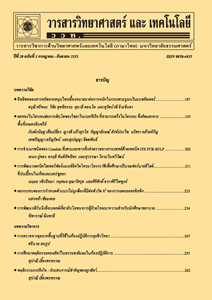การโคลนและการศึกษาลักษณะเฉพาะของยีนแอมิโลมอลเทสที่แยกดีเอ็นเอโดยตรงจากดิน
Main Article Content
Abstract
บทคัดย่อ
การศึกษานี้มีจุดประสงค์เพื่อคัดแยกยีนแอมิโลมอลเทสโดยตรงจากดีเอ็นเอของแบคทีเรียที่ปนอยู่ในดินโดยปราศจากการเลี้ยงเซลล์ สำหรับคู่ไพร์เมอร์ที่ใช้ในการทำพีซีอาร์เพื่อคัดแยกและเพิ่มจำนวนยีนแอมิโลมอลเทสได้ออกแบบจากบริเวณอนุรักษ์ที่ปลายอะมิโนและปลายคาร์บอกซิลิกของยีนแอมิโลมอลเทสในกลุ่มแบคทีเรียทนร้อน หลังจากเพิ่มจำนวนยีนแอมิโลมอลเทสแล้ว นำผลผลิตพีซีอาร์ขนาด 1.5 กิโลเบส เชื่อมเข้ากับ ดีเอ็นเอพาหะชนิด pGEM®-T easy และเคลื่อนเข้าสู่เซลล์ให้อาศัยสายพันธุ์ Escherichia coli DH5a เพื่อหาลำดับ ดีเอ็นเอ ผลการทดลองพบว่า open reading frame ของยีนแอมิโลมอลเทสมีขนาดเท่ากับ 1;503 คู่เบส แปลรหัสเป็นกรดอะมิโนได้ 500 ตัว โดยลำดับของกรดอะมิโนที่ได้นี้มีความเหมือนกับลำดับกรดอะมิโนของเอนไซม์แอมิโล มอลเทสจาก Thermus thermophillus ATCC 33923 ร้อยละ 99 จาก Thermus aquaticus ร้อยละ 86 และจาก Thermus scotoductus ร้อยละ 81 ตามลำดับ และเพื่อเพิ่มการแสดงออกของเอนไซม์แอมิโลมอลเทส จึงนำยีนแอมิโลมอลเทสในดีเอ็นเอพาหะชนิด pGEM®-T easy โคลนเข้าสู่เซลล์ให้อาศัยสายพันธุ์ Escherichia coli BL21 (DE3) โดยใช้ pET-17b เป็นดีเอ็นเอพาหะ โดยการแสดงออกของยีนแอมิโลมอลเทสจากเซลล์ให้อาศัยสายพันธุ์ E. coli BL21 (DE3) มีค่าสูงสุดเมื่อเหนี่ยวนำการเลี้ยงเซลล์ด้วย 0.5 มิลลิโมลาร์ IPTG นาน 6 ชั่วโมง เมื่อศึกษาคุณสมบัติทางชีวเคมีของเอนไซม์แอมิโลมอลเทสชนิดหยาบ พบว่าค่าพีเอชและอุณหภูมิที่เหมาะสมต่อการทำงานของเอนไซม์อยู่ที่พีเอช 9.0 และอุณหภูมิ 70 oซ และเอนไซม์นี้สามารถเร่งปฏิกิริยาการเปลี่ยนแป้งไปเป็นไซโคล เดกซ์ทรินชนิดวงใหญ่ขนาดตั้งแต่ CD23 ขึ้นไป โดยผลิต CD28 ในปริมาณสูงสุด
คำสำคัญ : ยีนแอมิโลมอลเทส; การคัดเลือกดีเอ็นเอ; การโคลนดีเอ็นเอ; ไซโคลเดกซ์ทรินชนิดวงใหญ่; ทรานสไกลโคซิลเลชัน
Abstract
The purpose of this study was to isolate amylomaltase gene directly from bacterial DNA present in the soil without prior culturing. The PCR degenerate primers were designed from N-and C-terminus conserved regions of thermophilic amylomaltase genes and used to amplify full-length amylomaltase gene. After PCR amplification; the 1.5 kb PCR product was observed. This PCR product was ligated with pGEM®-T easy vector and transformed into Escherichia coli DH5a for sequencing. The open reading frame of amylomaltase gene was 1;503 bp encoding an amylomaltase of 500 amino acid residues. The amino acid sequence showed 99 % silmilarity with Thermus thermophillus ATCC 33923 amylomaltase gene; 86 % similarity with Thermus aquaticus amylomaltase gene and 81 % similarity with Thermus scotoductus amylomaltase gene; respectively. In order to overexpress the enzyme; the amylomaltase gene was cloned into Escherichia coli BL21 (DE3) using the pET-17b vector. The maximum activity was obtained when the cloned cell was cultured at 37 oC for 6 h with 0.5 mM IPTG induction. When the biochemical characteristics of crude enzyme were investigated; they were found that the optimum pH and temperature were at pH 9.0 and 70 oC; respectively. This enzyme could hydrolyze pea starch to yield the large-ring cyclodextrins with degrees of polymerization of 23 and higher. It is noted that CD28 was the product in the largest amount under all tested conditions.
Keywords: amylomaltase gene; DNA screening; DNA cloning; large-ring cyclodextrins (LR-CDs); transglycosylation


